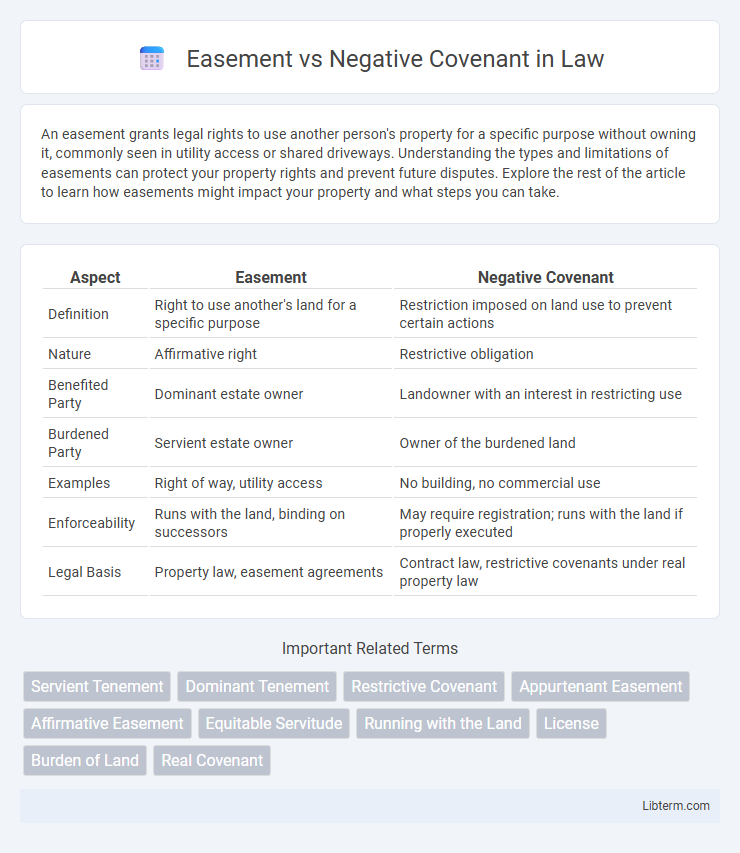An easement grants legal rights to use another person's property for a specific purpose without owning it, commonly seen in utility access or shared driveways. Understanding the types and limitations of easements can protect your property rights and prevent future disputes. Explore the rest of the article to learn how easements might impact your property and what steps you can take.
Table of Comparison
| Aspect | Easement | Negative Covenant |
|---|---|---|
| Definition | Right to use another's land for a specific purpose | Restriction imposed on land use to prevent certain actions |
| Nature | Affirmative right | Restrictive obligation |
| Benefited Party | Dominant estate owner | Landowner with an interest in restricting use |
| Burdened Party | Servient estate owner | Owner of the burdened land |
| Examples | Right of way, utility access | No building, no commercial use |
| Enforceability | Runs with the land, binding on successors | May require registration; runs with the land if properly executed |
| Legal Basis | Property law, easement agreements | Contract law, restrictive covenants under real property law |
Understanding Easements: Definition and Types
An easement is a legal right allowing one party to use another's property for a specific purpose, typically categorized into affirmative and negative types. Affirmative easements permit actions such as utility line installation or access pathways, while negative easements restrict property owners from certain activities that could affect neighboring land, like blocking light or drainage. Understanding easements involves recognizing their binding nature on current and future landowners, ensuring clear property usage rights and obligations.
What is a Negative Covenant?
A negative covenant is a legally binding promise that restricts a property owner's actions, prohibiting specific uses or developments on the land to protect neighboring property values. Unlike an easement, which grants the right to use another's property, a negative covenant limits how the property can be used, ensuring certain activities or changes are avoided. These covenants are often recorded in property deeds and enforced by courts to maintain agreed-upon restrictions.
Key Differences Between Easements and Negative Covenants
Easements grant a property owner the legal right to use another person's land for a specific purpose, such as access or utility lines, without owning it, whereas negative covenants restrict landowners from certain uses or activities on their property. Easements typically involve affirmative rights and are often attached to the land, binding successive owners, while negative covenants impose limitations or prohibitions to protect neighboring property interests and may require express agreement. Enforcement of easements generally allows for continued use regardless of ownership changes, whereas negative covenants depend on contractual obligations and may be subject to stricter legal interpretations.
Legal Foundations of Easements
Easements are legal rights granting a party limited use or access over another's property, rooted in property law and often established through express grants, necessity, or prescription. Negative covenants restrict property owners from certain actions to benefit neighboring land but do not grant rights of use, relying on contract and equity principles. The legal foundation of easements emphasizes enforceability against successors and ensures clear, recorded interests affecting title and land use.
Legal Foundations of Negative Covenants
Negative covenants are legally binding promises that restrict a property owner's use of land, grounded in contract law and property servitude principles. Unlike easements which grant certain rights to use another's land, negative covenants impose limitations to prevent specific actions, ensuring the burden runs with the land. These restrictions rely on clear, enforceable agreements often registered against the property title to maintain their validity and enforceability.
Rights and Obligations of Property Owners
Easements grant property owners the right to use another's land for a specific purpose, such as access or utilities, without owning it, while the burdened owner must tolerate this use. Negative covenants restrict property owners from engaging in certain actions, like building structures or using land in specific ways, thereby imposing obligations to refrain from activities that could affect neighboring properties. Both legal tools balance property rights and obligations, ensuring mutual interests are protected through enforceable agreements.
Examples of Common Easements
Common easements include right of way, allowing one party to cross another's land for access, and utility easements, permitting installation and maintenance of pipelines or cables. Easements grant specific usage rights over property without transfer of ownership, such as drainage or shared driveway access. Negative covenants restrict property owners from certain activities, like building structures that block a neighbor's light or views, unlike easements which allow active use.
Examples of Common Negative Covenants
Common negative covenants include restrictions on building heights, prohibitions against operating businesses, and limitations on property use such as forbidding livestock or noise disturbances. These covenants serve to protect property values and neighborhood character by imposing specific restrictions on how land can be used. Unlike easements which grant rights to use land, negative covenants prevent certain actions to maintain agreed-upon standards or conditions.
Enforcing Easements and Negative Covenants
Easements are enforceable property interests allowing specific uses of land, typically upheld by courts through injunctions or damages when interfered with. Negative covenants impose restrictions on land use, enforced by equitable remedies to prevent prohibited actions that diminish property value or violate agreed terms. Both legal tools protect property rights, but easements grant affirmative use rights, while negative covenants restrict certain uses, requiring clear documentation for effective enforcement.
Choosing the Right Legal Tool for Property Restrictions
Choosing the right legal tool between easements and negative covenants depends on the specific property restriction goals and enforceability requirements. Easements grant a property right to use another's land for a defined purpose, ensuring access or utility rights, while negative covenants restrict certain activities or uses on the land without granting access rights. Property owners must evaluate the scope, duration, and enforcement mechanisms of each tool to effectively protect land interests and comply with local property laws.
Easement Infographic

 libterm.com
libterm.com